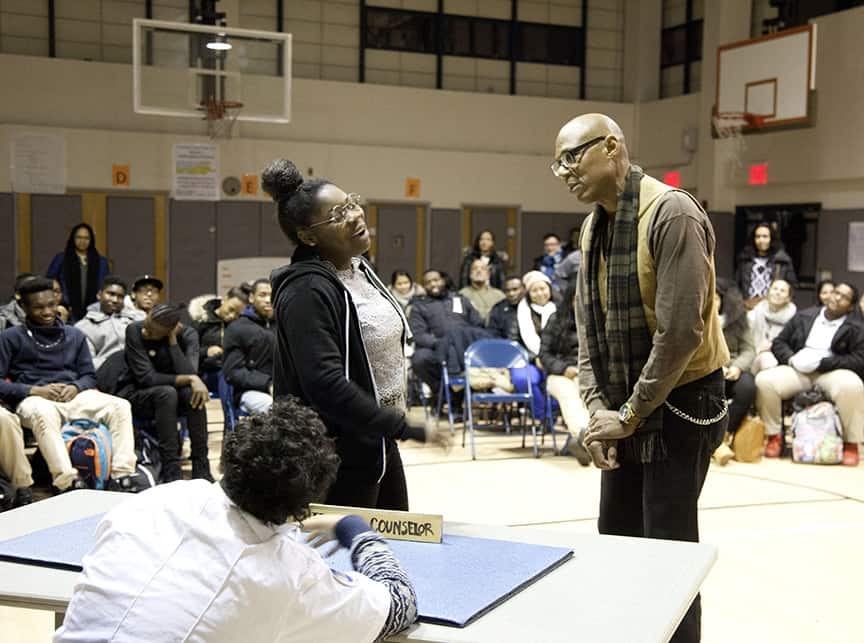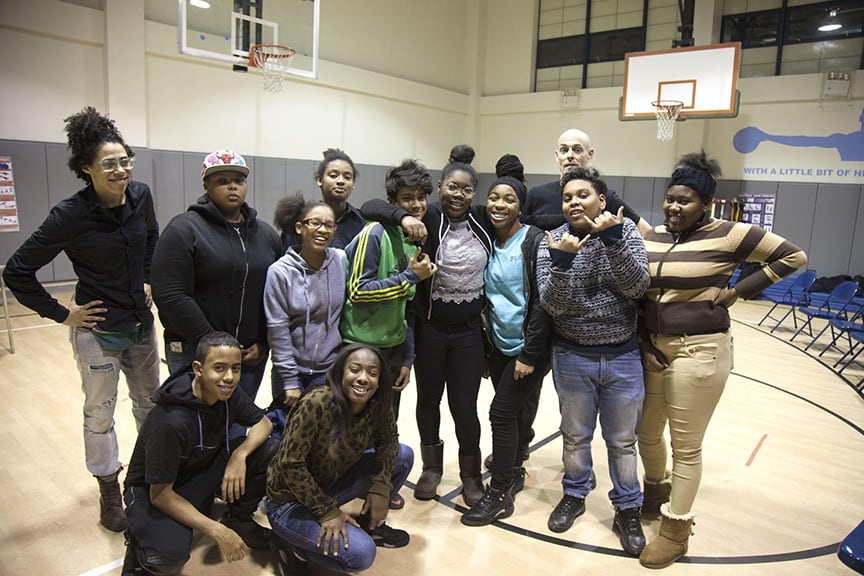
Alexys and Vincent, two friends in the eleventh grade, pass each other in the hallway.
Vincent stops in his tracks as Alexys approaches. He scrunches his face in a look of disgust. “Why are you wearing that?” he asks, sizing her up. “You don’t have the body for that!”
Alexys looks down, embarrassed.
Awkward silence…
“That was good!” Seventh grader Orion, a fellow scene mate, compliments the actors. “That was really good, actually, but maybe speak a little louder.”
A multi-colored mural presides over the rehearsal, spanning floor to ceiling in this Red Hook Community Justice Center (RHCJC) room. The word “Transform” is spelled out in a widening row of block letters that double as buildings. Three smiling children tower over the painted neighborhood.
Alexys, Vincent, and Orion – roused by new momentum they’ve found building their scene – swap similar smiles.
These three are part of RHCJC’s afterschool youth troupe. Nine middle and high schoolers have spent the 10-week program training in Theatre of the Oppressed, a creative practice that brings communities into direct dialogue with the oppression they face, as well as strategies for empowerment.
Under the tutelage of Theatre of the Oppressed NYC (TONYC), the troupe will perform their original play free to the public on Thursday at the Miccio Center.
Theatre of the people, for the people
Theatre of the Oppressed is uninterested in traditional three-act dramas.
At a TONYC performance, an original play devised within a community troupe is followed by an exercise in Forum Theatre. This interactive brainstorming session invites audience members – turned “spect-actors” – to step into the drama and improvise new strategies for tackling problems presented onstage.
The RHCJC troupe’s co-created play, “All Chained Up,” will cover community issues of racism, police brutality, body image, and gender roles through multiple scenes. Each vignette is grounded in real life experiences that the young performers have confronted themselves. They are protagonists in their own struggles for dignity, safety, and acceptance.
When groups chose issues to build scenes around, Alexys – who’s interested in theatre and social justice – felt most passionate about body image and gender roles. “That’s what I’m exposed to the most,” she says.
Theatre of the Oppressed is an interactive practice that harnesses theatre as a tool for social change. Brazilian director and educator Augusto Boal developed Theatre of the Oppressed during his country’s military dictatorship in the 1970s. Paulo Freire’s Pedagogy of the Oppressed, a theory that stresses dialogue and collaboration as means of flattening out hierarchies, served as a significant inspiration for Boal.
Innovative models
Katy Rubin, who founded TONYC in 2011, studied with Boal in Brazil. Each year TONYC presents over 60 performances – along with facilitator trainings and other workshops – with the goal of fostering conversations around community struggles that have the potential to catalyze creative change.
Rubin’s nonprofit has collaborated with Center for Court Innovation (CCI) sites, including RHCJC, for four years. “We find that at all the CCI sites we’ve worked with – including Staten Island and Harlem – the values and practices of alternative to incarceration, youth development, and community engagement align with our values and practices,” says Rubin.
To Viviana Gordon, RHCJC’s Executive Director, TONYC shares a kindred spirit with the court’s mission.
“The core of our work for a long time has been to put young people in the position to have a voice and recognize that they are incredible assets to their communities,” says Gordon. “Theatre of the Oppressed allows them to be at the front of sparking and driving change. It recognizes that they often have the most insight into the issues that have the most impact on their lives.”
The actors are paid to participate in the afterschool program. Gordon underlines the importance of compensation for all of RHCJC’s youth offerings as a way of professionalizing their work while valuing their time.
Lessons of accountability and punctuality are emphasized when such a stipend is involved, but Gordon also acknowledges that some participants and their families deal with real financial needs. “We recognized that youth can do many things to earn money, and this [program] is a really positive thing they can do for themselves,” she says.

A great act to follow
RHCJC launched its Theatre of the Oppressed program in fall 2016.
NYPD Officer Terence Williams visited one of the first troupe’s rehearsals in the fall. He and a colleague advised the actors on police jargon and precinct culture to help with character development.
“That’s the beauty of being an NCO,” writes Williams. “I am encouraged to be in these types of rooms interacting and engaging everyone and everything in it.”
When he attended RHCJC troupe’s performance in December, he was moved – but not just because he found the police officer characters realistic.
Williams was impressed by how the program facilitators “allowed the kids to use their own creative expression without any interference,” he says. “They were free to be natural and let their real emotion come out of every scene.”
Last semester’s culminating performance took place on a “horribly cold night” in December, Rubin recalls, but that didn’t stop parents, Red Hook locals, police officers, and even RHCJC’s judge, Alex Calabrese, from packing the house.
The original play and ensuing dialogue made for a lively evening “full of dissent and new ideas,” according to Rubin. The troupe tackled the community’s school-to-prison pipeline problem, making the night’s venue – public transfer school South Brooklyn Community High School – especially resonant.
“From that event, we saw that there was a real hunger for this program and these events in the community,” Rubin writes.
“We’ve been really fortunate to have [TONYC] as a partner and grateful for their investment in Red Hook,” says Gordon. She notes that several participants from the first youth troupe returned to RHCJC for additional programs.
When jokers are in charge
TONYC dynamic duo, Kate Clark and Storm Clementi-Thomas, are known as “jokers” in the Theatre of the Oppressed tradition. During the rehearsal process, these trained jokers lead troupes through games and exercises, then moderate the relationship between actors and audience during interactive shows.
“Since day one, there’s been so much fun in this room,” says Clark, a seasoned TONYC joker who started as an intern with the nonprofit. Behind her, waiting for the session to start, troupe members munch on program-provided snacks and catch up with cast mates.
After years in musical theatre, Clark expanded her arts practice to include issues of social justice. “I wanted to piece together art and activism, and work with people who bring their own experiences to art – not necessarily a trained theatrical background,” says Clark, who is currently pursuing a Master of Social Work in community organizing.
Clementi-Thomas, who does not identify with gender pronouns, also grew up with a soft spot for musical theatre. Though it’s hard to tell now, Clementi-Thomas once became shy about their theatre impulses and dove into activism instead. Eventually, Clementi-Thomas came back around to theatre and studied it in grad school, where they met a TONYC collaborator.
Clementi-Thomas stands in awe of the mature and pressing issues the young RHCJC troupe members choose to explore in their scenes. The joker’s voice lowers for dramatic effect: “And they can’t even vote.”
RHCJC troupe’s performance on June 22 promises to be a powerful, provocative night that celebrates the artistic and civic potential of Red Hook’s youth. The performers might not be voting age, but they are already amplifying their voices in creative ways.
Theatre of the Oppressed NYC and Red Hook Community Justice Center present “All Chained Up,” an original play, 5pm on Thursday, June 22, at the Miccio Community Center located at 110 West 9th Street in Brooklyn. The performance is free and open to the public. RSVPs can be made at www.tonyc.nyc or by calling (646) 504-4582.








